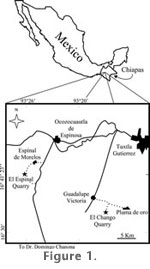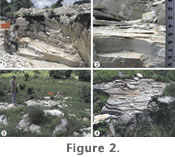| |
INTRODUCTION
 Since 1980, the number of reports on Cretaceous fish localities from Mexico has been growing steadily (Alvarado-Ortega et al. 2006b). The better known of these are: Tlayúa (Albian) in Puebla; Vallecillo (Turonian) in Nuevo León; at least five localities around Múzquiz (Turonian-Coniacian) in Coahuila; Xilitla (Turonian) in San Luis Potosí; Muhi (Albian-Cenomanian) in Hidalgo; and localities belonging to the Mexcala Formation (Turonian-Maastrichthian), Guerrero. Here we deal with the fish assemblage from two localities, El Espinal and El Chango quarries, which are located near Ocozocoautla de Espinosa, Chiapas, southeastern Mexico (Figure 1,
Figure 2). Since 1980, the number of reports on Cretaceous fish localities from Mexico has been growing steadily (Alvarado-Ortega et al. 2006b). The better known of these are: Tlayúa (Albian) in Puebla; Vallecillo (Turonian) in Nuevo León; at least five localities around Múzquiz (Turonian-Coniacian) in Coahuila; Xilitla (Turonian) in San Luis Potosí; Muhi (Albian-Cenomanian) in Hidalgo; and localities belonging to the Mexcala Formation (Turonian-Maastrichthian), Guerrero. Here we deal with the fish assemblage from two localities, El Espinal and El Chango quarries, which are located near Ocozocoautla de Espinosa, Chiapas, southeastern Mexico (Figure 1,
Figure 2).
El Espinal quarry
is located at N 16°41’1” and W 93°26’97”. Although it has been exploited since
the 1950s, its fossils began to be systematically collected and studied just
until recently (see
Ovalles-Damián and Alvarado-Ortega 2002;
Ovalles-Damián
2004;
Vega et al. 2006;
Alvarado-Ortega and Ovalles Damián 2008). The El Chango
quarry is located at N 16°34’14” and W 93°16’11” and little information
regarding the advances on the study of its fossils have been published (see
Ovalles-Damián et al. 2006;
Vega et al. 2007).
In the first work on fossils from El Espinal quarry,
Ovalles-Damián and Alvarado-Ortega (2002) suggested an Aptian age for this locality based on the occurrence of a paraclupeid fish (here referred as Paraclupea-like)
similar to Paraclupea
Sun 1956 from the
Aptian
 freshwater deposits of China. Soon after,
Vega et al. (2006,
2007), based on invertebrates from El Espinal and El Chango outcrops,
supported this same age for these localities; in addition, they suggested that
these deposits had been accumulated within a shallow lagoon or estuary with
occasional freshwater influence. freshwater deposits of China. Soon after,
Vega et al. (2006,
2007), based on invertebrates from El Espinal and El Chango outcrops,
supported this same age for these localities; in addition, they suggested that
these deposits had been accumulated within a shallow lagoon or estuary with
occasional freshwater influence.
The fossils so far collected in the Espinal and El Chango quarries include
different fish taxa, plant remains, mollusks, crustaceans, and
insects. The fishes known from these Mexican localities show close affinities
with those from Cenomanian assemblages located along the Middle East and Eastern
Europe (D'Erasmo
1946;
Arambourg 1954;
Forey et al. 2003; among others). Thus, the fish faunas described herein are
an outstanding discovery for Mexico and the entire American continent,
demonstrating for the first time the close affinities among Cenomanian fish
assemblages in opposite Eastern-Western extremes of the Tethys Sea.
Detailed descriptive works on fishes and other fossils from El Chango and El Espinal localities are still under preparation (except Triplomystus applegatei
Alvarado-Ortega and Ovalles-Damián 2008) and certainly will require additional effort in the fossil collection and preparation. Therefore, the aim of the present paper is to provide a preliminary description of these fishes in order to contribute to better comprehensive studies on the systematics, phylogeny, and biogeography of fossil fishes.
The fossil bearing strata at El Espinal and El Chango quarries constitute at least 3 meters of a monotonous dolomitic carbonate sequence. Unfortunately, the bottom and top of this sequence remain unknown. The thickness of the strata ranges from a few millimeters to about 15 centimeters. The strata show a light brown to yellowish color and parallel lamination. Occasionally, orange layers 1mm thick of iron oxides are exposed within the carbonate strata. Toward the top of the sequence (the last 30 centimeters), the carbonates alternate with clayish material, which could be a consequence of the dissolution during soil formation (Figure 2).
The strata exposed in El Chango and El Espinal have been assigned to the Sierra Madre Formation under the criteria of their geographic distribution within the Ocozocoautla area; however, at this moment the total thickness and lateral boundaries of these strata remain unknown. Besides, the present lithological description of these localities does not match with any of the 11 lithological units of the Sierra Madre Formation described by Steele (1986), so at this moment, there are not enough data to support a possible lithostratigraphic correlationship between both localities and the units of the Sierra Madre Formation. In addition, the absences of detailed biostratigraphic studies along with the lack of index fossils do not allow a certain age assignation of El Espinal and El Chango strata; for that reason, their precise temporal relationships within the Sierra Madre Formation are imprecise, too.
The specimens referred here are housed in the Museo de Paleontología "Eliseo Palacios Aguilera" (IHNFG), the Instituto Nacional de Antropología e Historia (INAH), and the Museo de Paleontología at Facultad de Ciencias, Universidad Nacional Autónoma de México (FCMP).
|